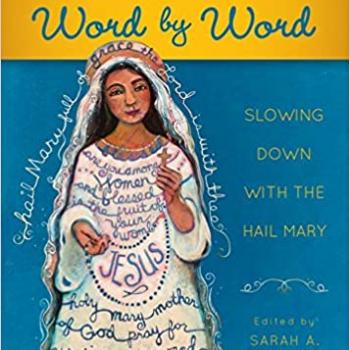H/T to Kate O’Hare, who linked to these initially puzzling comments from Pope Francis on weapons manufacturing and just warfare:
It makes me think one thing: people, leaders, entrepreneurs that call themselves Christians, and produce arms! This gives some mistrust: they call themselves Christians! “No, no, Father, I don’t produce them, no, no …. I only have my savings, my investments in arms factories.” Ah! And why? “Because the interest is somewhat higher …” And a double face is also a current coin today: to say something and do another. Hypocrisy …l But let’s see what happened in the last century: in ’14, ’15, in ’15 in fact. There was that great tragedy in Armenia. So many died. I don’t know the figure: more than a million certainly. But where were the great powers of the time? Were they looking elsewhere? Why? Because they were interested in war: their war! And those that died were persons, second class human beings. Then, in the 30s and 40s the tragedy of the Shoah. The great powers had photographs of the railroad lines that took trains to the concentration camps, such as Auschwitz, to kill the Jews, and also Christians, also the Roma, also homosexuals, to kill them there. But tell me, why didn’t they bomb that? Interest! And shortly after, almost contemporaneously, were the lager in Russia: Stalin … How many Christians suffered, were killed! The great powers divided Europe among themselves as a cake. So many years had to pass before arriving at “certain” freedom. It’s that hypocrisy of speaking of peace and producing arms, and even selling arms to this one who is at war with that one, and to that one who is at war with this one!
Here’s the Italian, which we’ll get to in a bit, but not how you think.
The puzzle is this: On the face of it, it sounds like the Holy Father is saying that it’s immoral to manufacture weapons . . . but that he wishes the great powers had gone to war more aggressively?
Is the Pope rolling around on the podium, tormented by a hawk on one shoulder and a dove on the other? No. Rather, there are several important language and thought patterns being used here that we need to recognize and understand.
1. “High Context” vs. “Low Context” Speech
When we say someone’s manner of speaking is “high context” what we mean is that there’s a whole backstory you need to know if you want to understand the real message. “Low Context” means that everything is completely spelled out for you. The statement stands alone, crystal clear.
Some cultures are well-known for being “high context.” Communication is subtle. You’re expected to read between the lines. People who don’t “get it” are considered a bit thick. They try your patience. High-context speech works well if the people communicating have the common experience necessary to pass subtle cues. This is why my older sister and I used to be able to win Pictionary every time: We could draw on a whole lifetime of references to inside jokes, family stories, and preferred words and phrases to quickly get a point across.
Americans as a nation use “low context” speech. We’re a nation of immigrants, and that massive diversity means that your neighbor probably doesn’t know what you’re referring to in your subtle hints or witty references. You have to spell everything out. We dislike jargon, we resent people who won’t say plainly what they mean, and we expect you to mean what you say and say what you mean.
Interestingly, though, American Internet Catholics are a high-context people. We have a whole collection of cultural references that quickly paint a picture of what we mean. Say, “the Spirit of Vatican II,” and an astute reader will look at the source (National Catholic Reporter or National Catholic Register?) and know exactly what is being implied, no further explanation necessary.
Because AIC’s live in this dual world, when someone uses a high-context reference to mean something other than what it usually (to us) implies, we expect it to be spelled out. If you tell someone on the internet, “I’m a social justice Catholic,” you know that you have to quickly say, “who is faithful to the magisterium of the Catholic Church!” unless you wish to be taken for someone who picks and chooses among the doctrines of the faith. Our high-context habits require low-context speaking to clarify anytime we deviate from code.
This creates a huge conflict with Pope Francis: He’s a high-context speaker, but who is using a completely different set of contexts than we American Internet Catholics are used to. His frame of reference is the deposit of the faith and his decades of living between two worlds: The richest of the rich and the poorest of the poor. We AIC’s are used to questioning whether someone believes and accepts the entirety of the Catholic faith; Pope Francis takes it for granted that it’s his job to promulgate the fullness of truth. We AIC’s are used to moral discussions focused on our particular corner of the world; the Pope is often referring to circumstances utterly unlike our own.
2. Linear vs. Interconnected Thinking
If your brain works properly, by the time you’re forty it won’t think like it used to. When you were younger, you were an ace at memorizing things. You could walk into math class, learn a fact or a process, practice a bit, and spit it out for the test. As long as the problems on the test were the type of problems you’d seen on your homework, you could run circles around the old guys.
And then one day your brain grows and changes, and suddenly when you sit in on a presentation at work, there’s a 95% chance you won’t remember the facts and figures on the powerpoint like you used to when you were twenty, and also a 95% chance that you are thinking about the presentation and connecting the new information to thirty other things you’ve learned over the decades. A twenty year-old thinks in subjects; a forty-year-old thinks in systems.
When Pope Francis speaks off the cuff, he almost never lays out a fifth-grade catechism lesson. What he does is grabs examples, often competing examples, from all over the place. He tosses them in front of you, and says, “Connect the dots. There’s a pattern here? Can you see it?”
3. Sound Bite vs. Developed Arguments
The law of the soundbite is this: Never ever make a statement that requires two sentences in order to understand it properly. Dilly-dally like that, and the media will eat you alive. Imagine, for example, that you said something like this:
Sometimes I wonder whether it’s worth sacrificing to send my children to a good Catholic school. Then I look at the spiritual, social, and academic benefits, and I know it’s the best decision for my family.
Anyone who reads both sentences knows that this is a quote about the goodness of the speaker’s particular parish school. But the popular press wants blood, and thus the headline becomes, “Catholic Parent Doubts Value of Parish School.” We are trained to never, ever formulate a thought that isn’t fully-expressed in a single sentence. Even semicolons are risky.
Pope Francis doesn’t obey this law. It’s as if he thinks it’s perfectly acceptable to take multiple sentences, multiple paragraphs, sometimes even a whole encyclical, to lay out his ideas in succession, each part contributing to the whole. He expects you to listen, perhaps ask yourself questions as you listen, but to wait until the idea is fully presented. Only when he’s done talking do you have the whole story; until then, he’s not done.
***
If we use these three principles of communication — which are not difficult, they merely require that you not be obtuse — his message about warfare and weapons manufacturing makes perfect sense.
Because he’s a high-context speaker, we know that his statements can only be understood in light of the Catholic faith and the particular historical and social situations to which he is alluding. Just warfare and legitimate self-defense are part of the deposit of the faith. Also essential to the faith is a rejection of consequentialism: We may not do evil that good may come of it.
In condemning investors in weapons factories who look only at the profits and care little about to whom the weapons are sold, he’s referring to this second problem. Pope Francis condemns those who claim that a better return on their financial investment excuses them from looking into a serious problem: Investing in a company that sells weapons to warmongers. The Catholic faith, though simple, is not simplistic. In condemning the lack of intervention in the Armenian genocide and the Nazi Holocaust, he’s referring to the first principle. There’s a time for just warfare: The great powers knew these slaughters were taking place and didn’t come to the defense of the innocent.
Because he’s an interconnected thinker, the examples roll off quickly from all directions. One minute he’s citing the modern investor, perhaps referring to a scandal involving an arms manufacturer you’ve never even heard of yourself. The next minute he’s in Armenia in 1914, then, hop!, we’ve got Nazi railroads. This is where the Italian gets interesting — even if you have very bad Italian (as I do), you can read the text and pick up the rhythm of his speech, the way the examples roll off almost exactly the way my friend’s Italian mother used to sit in the kitchen complaining about industrial food products or kids these days. It’s a literary style that supports a thinking style, and if you ignore the poetry of it, you’ve lost the genre.
Because he doesn’t care about soundbites, you can’t get his meaning from a snippet quote. Oh sure, sometimes Pope Francis says something that is eminently tweetable. But not here. Here he’s picked up a subject, and he’s working around it piece by piece, throwing out examples and ideas, and saying to you, “Put the pieces together. You’re a smart kid. Can you see how this fits? Can you see how these very different things all point in the same direction? Can you see how the love of your fellow man takes such different turns in different times and places?”
That’s Pope Francis on weapons: Please don’t supply terrorists, but if you see people getting deported to a concentration camp, kindly cut the rail line so those trains can’t run, okay?
***
Laudato Si’ is written much more carefully than these informal remarks, and the arguments are developed more explicitly. Still, the same rules apply:
- You have to have a working knowledge of the Catholic faith, Catholic social teaching, and the situations to which he is referring in each instance. It’s high-context at times, but it’s not high-context American Internet Catholic, it’s high-context from a completely different frame of references. (And sheesh, it’s really not that bad. Editors worked hard to make it understandable to anyone who’s versed in the relevant issues.)
- The encyclical approaches the problem of environmental stewardship from a massive set of interconnected approaches. Laudato Si’ wanders all over the map, and well it should — it’s about the whole map.
- The Holy Father’s teaching is developed piece by piece over the totality of the 200-some paragraphs. No one section tells the whole story. The whole story tells the whole story.
Use those principles, and you’ve got Pope Francis in the bag.
Related: I review The Culture Map by Erin Meyer here, a useful book for improving your cross-cultural communications. Highly recommended.

Photo by Slaunger (Own work) [CC BY-SA 3.0], via Wikimedia Commons Boeing FA-18F Super Hornet at take off Danish Air Show 2014-06-22












